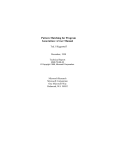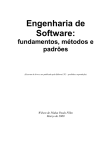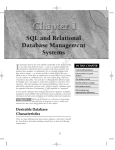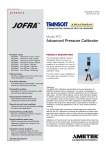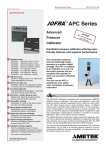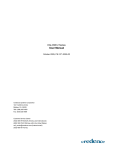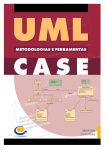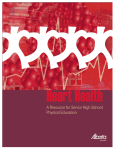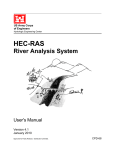Download as a PDF
Transcript
Developing Engineered Product Support Applications H. James Hoover1, Tony Olekshy2, Garry Froehlich1, and Paul Sorenson1 1 Dept. of Computing Science, University of Alberta, Edmonton, Alberta: 2Avra Software Lab Inc., Edmonton, Alberta. Key words: Product Lines, Application Frameworks, Engineering Applications, Software Architecture Abstract: Product line developers have two primary problems to solve: keeping their applications relevant to the associated manufactured product line, and evolving their applications to exploit new information technologies. This paper reports on our experience in developing commercial applications for engineered product manufacturers. High quality object-oriented frameworks with good factoring into services are crucial to addressing both of these issues. We have also learned that it is not sufficient to develop frameworks that address only the development of the application. They must also support other parts of the process: from production of documentation, through help desk integration, to defect tracking and resolution. This work also contains a catalogue of best practices and advanced features the we believe will be valuable to other builders of engineering tools. 1. INTRODUCTION During the last five years we developed a number of commercial applications for manufacturers of engineered products. Our applications support the marketing and sales activities of manufacturer's main product line — in this case pressure safety relief valves and booster pumps. These are not shrink-wrap applications for a generic market, and they are not the primary product of the manufacturer. The users of the application include the manufacturer, its distributors, and the product customers. All are experts in the product domain, but have widely varying levels of expertise in installing and using software. 1 2 Hoover, Olekshy, Froehlich, and Sorenson In addition, we developed groupware applications to support the users and the developers of those applications. This paper reports on the objectoriented framework approach we use, the experience we gained and the lessons we learned from our successful efforts in engineered product support using application line technology. The paper begins by describing what we mean by engineered products and application line support for these products. We distinguish a product line (the actual artefacts manufactured) from an application line (the software applications that support the product line). Section 2 describes in greater detail the general context for engineered product support that we discovered and incorporated in our EAF (Engineering Application Framework). Section 3 elaborates on application workflow, which is one of the most difficult and important parts of the requirements that must be well understood for successful engineering product support. Additional engineering requirements are presented in Section 4. Section 5 provides an overview of the frameworks we have developed that support the engineering product requirements identified earlier in the paper. Section 6 describes some advanced features that we incorporated in our framework as it matured through many releases using a rapid evolutionary development approach. We conclude with a recap of the advantages of the application line strategy we used, and the experiences gained and lessons learned. 2. ENGINEERED PRODUCT LINES AND PRODUCT LINE APPLICATION SUPPORT 2.1 Application Domain Background Avra Software Lab (www.avrasoft.com), working in collaboration with the Software Engineering Research Laboratory at the University of Alberta, has developed applications for manufacturers of pressure safety valves and booster pumps, both of which are good examples of engineered products. We have developed Internet-based help desk applications to support the users of the engineered product applications, and created and used groupware applications that provide planning, scheduling, accounting, and document repository functions in support of the development of these applications. Both of these are examples of software used to support the applications line development for engineered products. We have also developed multiple instances of these applications using both thick-client LAN-based technology (which we call the Kalos technology) and thin-client WEB-based technology (referred to as the Prothos technology). Developing Engineered Product Support Applications 3 Table 1 categorizes some of the applications by product line domain and the technology used to build the application. The user's domain for each application is shown in italics. Table 1. Application Support Categories Product Line Framework Architecture / Technology Kalos Prothos Thick Client / LAN Thin Client / WEB Engineered Products SizeMaster 4 SizeMaster 5 Sprague Pumps Valves Valves Pumps GroupWare Task Manager Help Desk Café Avra Software Valves Software SizeMaster is an engineered product application that supports the sizing, selecting, and ordering of pressure safety relief valves for Farris Engineering. These valves are used to protect a pressure vessel (such as a boiler) from exploding in the event that something impairs its normal operation. Although a simple device, essentially a spring loaded diaphragm over an orifice, these valves are a canonical example of an engineered product. The Sprague Pumps application supports the sizing, selecting, and ordering of Sprague booster pumps. These pumps use part of the energy in a pressurized source of fluid to deliver the remainder of the source at higher output pressure. They are often used to drive high-pressure devices from a high-volume source of shop air. In general, the function of these support applications is to bridge the business and engineering processes and workflows of the product line manufacturer and their customers. They are also used to support marketing and sales activities for the manufacturer's product line. For example, they typically contain the product catalogue, and the customer is not charged for their use. They are not shrink-wrap applications for a generic market, and they are not the primary product of the manufacturer. These applications are essentially database-centric. A database is used to store the business objects, such as customers, jobs, and orders. A client, run on the user's desktop, is used to access and manipulate the business objects. The users of the application include the manufacturer, its distributors, and its customers. All are experts in the product domain, but they have widely varying levels of expertise in installing and using software. The applications must have relatively low cost of learning for a new user, yet be sophisticated enough to support an expert user in a production setting. The manufacturers of the engineered products are not software development organizations, so they have outsourced the development and support for their applications. Support for these applications is complicated 4 Hoover, Olekshy, Froehlich, and Sorenson by the fact that product support is done by the manufacturer's engineering staff, while software support for the application is done by the application line company (in our case Avra Software Lab). 2.2 Similar Frameworks — Different Technologies In this development we uncovered a number of important, advanced features that are common to engineered product support. We incorporated these into a number of O-O sub-frameworks, which allowed us to share common architectures, and much of the code, across these applications. Each sub-framework encapsulates shared code as well as services and hooks for the application developer that are independent of the implementation technology. The nature of these services will be discussed further in Section 6. Two very similar architectures are used to tie the individual subframeworks into an application, loosely "modelled" in Figure 2 and Figure 3. A Kalos thick-client implementation and a Prothos thin-client implementation of an application are designed to do more-or-less the same job. The differences between the frameworks are due principally to the differences in implementation technology that has occurred with the adoption of WEB-based computing. Section 5 will describe some of the components of these architectures in greater detail. One of the challenges that framework developers face is that changes in technology can render their framework implementations obsolete. We very quickly realized that the implementation technology of the framework is less important than its architecture. It is possible to migrate a good design to a new technology. In fact we have been using some of the architectural ideas behind these frameworks for over a decade. The different technologies used in implementation are shown in Table 2. Table 2. Framework Technologies Framework Kalos Technology EAF: Engineering Delphi, embedded Application Framework PCS: Product Catalogue Delphi, embedded Service UIM: User Interface Delphi, Windows Manager POM: Persistent Object Delphi, BDE + SQL Manager Prothos Technology Delphi, server, HTTP Perl, server, HTTP Perl, Browser, HTML Perl, DBI/DBD + SQL Developing Engineered Product Support Applications 2.3 5 Framework Development Process Our strategy for building frameworks could be described as continuous service refactoring in the context of a stable, relatively technology independent, connecting architecture. That is, the evolving problem requirements suggest common functionality that can be collected into subframeworks that deliver a specific service. These sub-frameworks attach to specific points of a very general high-level architecture. Our efforts to determine the requirements for supporting engineered products have occurred over the past five years. The original requirements for SizeMaster 4 were the existing SizeMaster 3, and the manufacturer's desire to build a new application for the Windows environment. After an evaluation of the existing application, discussion with the manufacturer's application line champion, and the usual brainstorming and whiteboard drawings, the need for and advantages of a general model of this style of application became apparent. The common process of sizing, selecting, and ordering was identified and embellished over time. In particular, we found that the requirements for these types of applications can be classified along the following lines: 1. Product Specific Requirements: This includes the details of the particular product line, such as the sizing standards to be followed, the detailed catalogue information, and any idiosyncrasies in the workflow. 2. Engineering Process Requirements: These are the activities necessitated by the fact that these applications are being used by engineers and must support engineering processes, as well as business processes like quoting and ordering. 3. Generic Application Requirements: These are related to the quality and flexibility of the application in general, including multi-user considerations, user interface design, the ability to use various database systems, testing, support, and so on. It became clear that the technical requirements for engineering-standards based calculations were precise, but that the workflow was going to evolve quickly as we tried to understand how the engineer would use the tool. Instead of continuing to refine the requirements, we used a rapid evolutionary approach [McConnell, 1996]. We build the applications incrementally, with varying degrees of flexibility among their major components. For example, forms layout and workflow are very flexible. Although the database schema does not change quite so rapidly, we provide automatic schema migration. The least flexible is the implementation of the engineering standards, since restructuring the worksheet introduces migration issues for existing worksheets, and also necessitates a thorough review to ensure it is still correct with respect to the standards. 6 Hoover, Olekshy, Froehlich, and Sorenson The software engineering challenge is to provide the capability to quickly and accurately generate new applications of this type, and to evolve existing ones to support their product lines. One pleasant aspect of this kind of application development is that since the applications are not the main revenue stream for the manufacturer, they tend not to be under pressure of creeping features in order to produce a stream of new revenue generating releases. This is not to say that there isn't a continuous stream of feature requests, but these tend to be from users and of the kind that add value to the application. The next two sections will examine the workflow and engineering requirements of the engineered product domain that influenced our framework design. 3. WORKFLOW REQUIREMENTS Figure 1 shows the relationship between the user's business processes and the sizing, selecting, and ordering workflow supported by our engineered product applications. Each application integrates design tool, smart catalogue, and order processing. For each product line produced by the firm, there are one or more applications to support that product line. The applications are used by both customer and supplier in a way that interconnects the supplier and customer business processes. Figure 1. Workflow Model A common characteristic of engineered products is that they require some relatively complex decision making, called sizing, prior to being selected and Developing Engineered Product Support Applications 7 ordered. The term engineered product covers many kinds of manufactured items, but it can also include services like insurance policies or retirement plans. The main characteristic of an engineered product is that some assistance is required in order to decide what particular item to order. For example, one does not simply order a pressure safety relief valve from a catalogue. First you must determine your scenario's parameters, such as working pressures and temperatures, kind of fluid (gas or liquid), amount of fluid to be relieved and so on, and then using some engineering standard, such as ASME Section 8, compute the dimensions of the orifice of the value sufficient to relieve the pressure and protect the vessel. After sizing comes selection. Given the required size, there will be a number of candidate products in the catalogue from which one will be selected (perhaps on the basis of cost). During selection, there are usually a number of trimming options, such as type of steel, that can be chosen without affecting the computed size. Sizing and selection can be iterative, in that decisions made during sizing can affect the range of candidate products available for selection. Sets of products are grouped into jobs, so once the products in a job are selected the entire job can be sent to the supplier for ordering and quoting. Depending on the result of the quote, the order may be accepted, modified by the customer, or abandoned. 4. ENGINEERING REQUIREMENTS Since these applications are primary used by engineers, we must consider the demands that are made on our application as a result of engineering process requirements. That is, what distinguishes an engineering application from a typical business application such as a spread-sheet or order processor? The first thing to recognize is that because engineers are professionally responsible for their work, they are not a normal application user. Put bluntly, an engineer should not automatically trust an application. The application has to earn the confidence of the engineer. How does it do this? Our approach is to earn the confidence of engineers by building applications that embody the following principles: 1. Consistency: The user interface and program behaviour must be consistent for all tools. This is particularly important with respect to the display and entry of data: how values and their associated units are displayed, how base units are maintained, and how input and output changes are brought to the attention of the user. 8 Hoover, Olekshy, Froehlich, and Sorenson 2. Observability: Many applications deliberately hide process state information from the user and instead guide them through a predetermined path. Our philosophy is that the user is the best judge of how to complete the process, and that the tool should ensure that the user is aware of what has been completed, what remains to be done, and what effects the current action has. 3. Verifiability: Our applications provide the ability for independent verification of their behaviour. The entire calculation, both as displayed and as maintained internally, can be verified by an independent agent. Unlike most engineering tools, we give the engineer the ability to perform independent verification using a program of their own design. 4. Auditability: All tools must be able to check their inputs for tampering or corruption, and produce outputs with the same properties. We want the same level of certification as a stamped and signed drawing. 5. Extensibility: The application builder cannot anticipate all the possible application scenarios, so it must be possible for the engineer user to extend the tool to handle their special situation, while preserving all of the preceding properties. So not only does the application need to perform the correct math and physics, it needs to track revisions and approvals, and generally know who did what and when in order to support proper engineering process. Furthermore, new products can be introduced, which can require new support in the application. Catalogue data can change, which then invalidates existing installed copies of the application. Engineering standards can change, which not only invalidates existing installed copies of the application but also can call into question the sizing of existing installed products. Fortunately, new products go through an extensive design and approval process, and standards tend to change slowly; therefore, existing products do not change that much. Consequently, we are not faced with the kinds of radical changes in functionality associated with applications in some other markets, like software browsers. Our applications tend to evolve via numerous small incremental changes, via our rapid evolutionary development process. 5. APPLICATION FRAMEWORKS For us, framework technology is a pre-requisite for evolutionary development. As of this time, we have made roughly 40 releases of SizeMaster 4. Our goal is to use frameworks to reuse as much of the process and generic capabilities as possible over the application line. New Developing Engineered Product Support Applications 9 applications in the line are constructed by using product specific hooks [Froehlich97, Froehlich99]. The frameworks capture the features common to a broad range of engineering applications, and can be reused. New applications are made by attaching the domain specific code of the application to hooks in the framework. Depending on the particular problem, a new application thus accounts for 20 to 30 percent of the code, while the remainder is reused from the framework. As mentioned earlier, we have two distinct architectures that we maintain. The Kalos architecture is intended for building desktop-based thick-clients with a central database. The Prothos architecture is intended for building browser-based thin-clients that deliver an application over the web from a central server. The important thing to notice is the structural similarity between the two architectures. This is primarily due to the fact that we view an application as a loosely coupled composition of services. (The role of services in evolution to the web is examined in [Froehlich99b]). The Kalos and Prothos architecture models shown in Figure 2 and Figure 3 decompose into sub-frameworks as follows. The EAF (Engineering Application Framework) and the PCS (Product Catalogue Service) are spatially in the center of the models. The UIM (User Interface Manager) and POM (Persistent Object Manager) wrap the EAF and PCS services to make applications out of them. The user interface consists of the nodes to the left and front of the models. The user interface forms written by the application developer are represented by the UI nodes. The UIM framework consists of the UIM node, which is responsible for marshalling the nodes below it (which contain the classes that implement the actual user interface components and widgets). Persistent objects are handled by nodes to the back and right of the models. The business classes written by the application developer are represented by the BC nodes. The POM framework consists of the POM node, which provides an abstract base class for the business classes, and a singleton for managing the working set of business objects. The POM is responsible for invoking the services of the nodes below it (which contain the classes that implement our actual OORDBMS via SQL). 10 Hoover, Olekshy, Froehlich, and Sorenson Figure 2. Kalos Framework Architecture Model Figure 3. Prothos Framework Architecture Model Developing Engineered Product Support Applications 11 The application itself is represented by the large node at the top of the models. With Kalos, the application is conceptually a set of menus that dispatch instances of UI form classes. With Prothos, the application is conceptually a set of URLs that encode instances of the UI page classes. In Kalos, the UIM manages the application frame and menus, dispatches new UI instances, and manages the set of concurrently active UI instances. In Prothos, the UIM is the HTTP daemon that serves the application, which converts the requests for URLs representing UI instances into HTML responses for the client. In both cases, the UI classes are responsible for selecting and manipulating instances of business classes, which in turn are made persistent by the POM. The edges in the architecture models represent inter-service communication, which the application developer sees as API methods. In Prothos, inter-service communication is physically implemented via internetworking channels, so the services can be provided by multiple processors and the user interface can be physically de-coupled from the local context of the service providers. In Kalos, the communication between the services is constrained to a single processor (or two, when the database is controlled by a separate server). Viewed statically, the architectural models show the relationships between the classes in the frameworks. Viewed dynamically, they show the interactions between the objects accessed by users at run time and the services that manipulate those objects. Frameworks have many benefits, the two most important being that features are implemented consistently across applications, and that the time to construct the application is dramatically reduced. From an application line perspective, the code in the framework is less important than the architecture it embodies. For example, in implementing the web delivered SizeMaster 5, we replaced the entire Kalos thick-client code base, but used essentially the same architecture. Engineering applications are notoriously difficult to fully specify, primarily because the presence of a tool enables the engineer to do more in new ways, and this affects their perception of the problem they wish to solve. Our framework technology enables us to rapidly produce a series of prototypes that evolve along with the client's understanding of the problem that they wish to solve. This approach works well with the dynamic nature of engineering applications. 5.1 EAF Framework The Engineering Application Framework is used to build engineering worksheets. Each worksheet is a collection of data elements and calculations 12 Hoover, Olekshy, Froehlich, and Sorenson that represent the contents of an engineering code or standard. Each engineering application that we build has one or more worksheets that capture the product-specific engineering calculations of the application. Sizing interacts primarily with the worksheets. The user interface of the application, provided by another framework, navigates through the worksheet but does not do any engineering computations. In this way we keep the robust core engineering part of an application relatively isolated from the more fragile user interface. Many engineering calculations are organized around the concept of a worksheet and therefore we incorporated it as a key concept in our framework. The worksheet guides the engineer through the calculations, reminding them of important steps, ensuring that key decisions and subcalculations are made in the proper order, and recording the process for future review. Having performed and verified the calculation, the engineer then signs the worksheet and it becomes part of the permanent design documentation of the project. A worksheet is a hierarchically organized collection of interdependent calculations. Each calculation can be thought of as a black box. The box has a set of inputs from other calculations, a set of outputs which go to other calculations, some local data which is its state, and some external settings taken from the outside world. Each calculation is given a type. Each calculation performs some operations on its inputs, externals, and locals, and produces some outputs. Calculations are structured so that they cannot alter their inputs or externals. Locals can be read and modified, and outputs can only be modified, not read. Furthermore, only one calculation can change the value of an output, thus ensuring that values can be traced back to their origins. Figure 4 shows a screen shot view of a subcalculation in the SizeMaster 4 worksheet. Unless the user is familiar with the worksheet, they will normally need guidance as they navigate through it. This guidance is provided through scenario wizards. A scenario wizard sits "above" the calculation, with links hanging down to the locals and externals needed for its particular scenario, as in Figure 5 below. Developing Engineered Product Support Applications Figure 4. Worksheet View Figure 5. Workflow Wizards 13 14 Hoover, Olekshy, Froehlich, and Sorenson Figure 6. SizeMaster 4 - Workflow Wizard Figure 7. SizeMaster 5 - Workflow Wizard Developing Engineered Product Support Applications 15 The wizards in Figure 6 and Figure 7 take the user through the workflow involved in computing the orifice area for a scenario in which the flow out of a pressure vessel is blocked for some reason. Note the similarity between the Kalos-based and Prothos-based versions. The underlying calculation and workflows are identical, only the view has changed. This is an example of using frameworks to preserve behaviour across technologies. 5.2 PCS Framework The product catalogue service determines, for a given engineering worksheet, the recommended products from each series of models in the manufacturer's catalogue that are suitable for the given engineering scenario. In addition, given any model number from the catalogue, the catalogue service can determine whether or not the model is suitable for the given scenario. The model numbers for engineered products can be quite complex, such as 26MA10-120/S3 or S-216-JD-34-SS, because they encode all the details needed to completely select a single engineered product from the manufacturer's product line. The relationship between model numbers and the engineering worksheet is also complex, because changing a single option in the model number can create exceptions to the normal candidate selection process, depending on the values of the variables in the worksheet. Rather than maintain a complete list of all possible model numbers, which in many cases would be prohibitively large, the PCS uses the following information and a set of rules to determine the complete list of model numbers. 1. A table specifying how to parse model numbers into their fields. 2. A table specifying the valid values for each field of the model number. 3. A table specifying valid base model numbers, which are usually the first few characters of the model number. This table contains the key selection parameters for each base model, such the range of pressures and temperatures for which the product can be considered a candidate for selection. 4. A table specifying how the values of model number fields affect the default materials used for the parts of the product. The PCS provides an abstract base class upon which the application developer bases the model number class. The application developer implements abstract methods, for the base class, that provide the common find-candidates, is-candidate, and get-attribute methods for the product line. These methods use the tables described above to find appropriate pressures, 16 Hoover, Olekshy, Froehlich, and Sorenson temperatures, and materials; they implement the rules that are common to all models in the product line. The application developer also writes a descendent class for each product series in the catalogue (typically determined by the first character or two of the model number). These descendent classes can override methods for key steps in the find-candidates, is-candidate, and get-attribute methods of the common class. For example, the applicable temperature range can be restricted for /S4 models in the 26 series, or the spring material can be changed from the default steel for 55AB99-4 models to nickel when the pressure is over 1200 PSI, unless the /M option is selected, in which case the spring is chrome-moly. Figure 8 and Figure 9 contains screen shots of product selection forms for the SizeMaster 5 and Sprague Pumps applications. Here the point to observe is that much the same kind of activity is involved in engineered product selection regardless of the kinds of products. This is an example of the more typical use of the frameworks preserving behaviour across applications. Figure 8. SizeMaster 5 - Product Selection Developing Engineered Product Support Applications 17 Figure 9. Sprague Pumps - Product Selection 5.3 UIM Framework From an external perspective, Prothos-based applications can be thought of as a set of web pages that operate on instances of a set of persistent business classes. Kalos-based applications can be thought of as set of desktop windows that operate on instances of a set of persistent business classes. In either case, the application developer is responsible for laying out the forms in the web pages or desktop windows, for connecting the data modification controls in the forms to the attributes of persistent objects, and for specifying user interface controls and callback methods to handle workflow operations. Both Kalos and Prothos use a traditional browse, query, zoom, view, and edit model for user navigation through the business classes. Each of the browser, viewer, and editor forms contains a number of database-aware user interface widgets that provide the users with access to the attributes of the business objects. The UIM looks after communicating with the POM to automatically move data to and from these widgets. The user interface forms also contain widgets for dispatching the workflow methods of the business classes. The UIM passes these operations 18 Hoover, Olekshy, Froehlich, and Sorenson to the business objects, which implement the rules for modifying their persistent attributes to effect the operation. The UIM then updates the user's view to show the new persistent attribute values, which causes the user to see the result of the selected operation. Figure 10 and Figure 11 contain screen shots of the master/detail browse/view forms for an instance of a SizeMaster 4 Job class, and for a Sprague Pumps orders browser. 5.4 POM Framework The POM provides the abstract base class for an application's business classes, and it manages the set of concurrently active business objects. The business classes represent traditional entities like customer, order, tag, and product. Each business class is defined by an extended schema (describing the properties of the persistent objects in the class) and a set of business methods that implement the domain-specific business rules for the class. The POM is responsible for managing login controlled database access sessions and for assuring the consistency of concurrent transactions. It handles roll-back, roll-forward, referential integrity, database rebuilds, schema conversions, and backups. It co-ordinates interaction with the underlying RDBMS engine via SQL. Figure 10. SizeMaster 4 Job View Developing Engineered Product Support Applications 19 Figure 11. Sprague Orders Browser 6. CATALOGUE OF ADVANCED FEATURES Application quality is the result of attention to many details. This section is a catalogue of some of the important features or best practices that in our experience lead to a quality engineering application. Our intent is that the experienced application developer should identify with many of these, and find some novel ones. The external interfaces to the applications are deliberately chosen to exploit the experiences of the typical user of Windows-based and Browserbased applications. The crucial application line details are behind the scenes and not visible, or appreciated, by the casual user. In this section we examine how we support these aspects of the application. Since these features are relatively consistent between applications in the application line, we have incorporated them into our application frameworks. Depending on the nature of the feature, it is either incorporated directly in the framework as a hook, or the feature is generic enough to be incorporated into the framework. For the purposes of this section, we have divided the advanced features into these general categories. 1. Core Features of interest to any application in almost any domain. Many of these features are geared to making problem diagnosis easier for developers and the help desk. 20 Hoover, Olekshy, Froehlich, and Sorenson 2. Engineering Features of interest to applications that need to support engineering process 3. Persistence Features of interest to any application that stores its business objects in a database. 6.1 Core Features 6.1.1 Trouble Stack In our experience, the single most important facility in an application is the trouble stack. As exceptions are generated, explanatory messages are pushed onto the trouble stack. For example, an attempt to grab a write lock on a record might fail because the record has been updated by someone else. The failure generates an exception with message "database changed by someone else". The code attempting to obtain the write lock can catch the exception, stack the message "can't save changes to database" and continue unwinding. Similarly the top level code attempting to post the transaction could stack the message "can't send order to quoting". Unwinding the trouble stack provides an explanatory narrative for both the user and the developers. For example: "Can't send order to quoting because can't save changes to database because database changed by someone else." The trouble stack output window has a copy to clipboard feature that can be used to email the entire stack trace to the help desk. Since all our messages are uniquely numbered with a code that is easy to search for in the source, we can quickly determine where the application was when the failure occurred. 6.1.2 Data Signatures We compute MD5 checksums on all configuration and crucial data files in order to detect tampering or corruption. For example SizeMaster will not start if the valve catalogue data is incorrectly signed. As evidence of its practicality, we note that when introduced, this feature caught a few cases where experienced users were altering the data files in order to handle situations not yet built into the tool. Knowing that the configuration data and database files have a high probability of being consistent saves substantial diagnostic time. Developing Engineered Product Support Applications 6.1.3 21 Configuration Report This report indicates the state of the particular installation, such as the characteristics of the machine, the directory the application is installed in, and where the database middle-ware is located and what version it is. 6.1.4 HTML-based Reports and Displays We made an early decision to use HTML for all reports and 2D text layouts on forms. The constraint-based layout of HTML simplifies the resizing of forms. We employ a subset of HTML, with our own browser (a source-licensed component from a supplier) that we modified to have page breaking and numbering, and a facility for rendering equations. Reports can be emailed to users without the enhanced viewer using the MIME encapsulation standard for multi-part forms. 6.1.5 Apalon markup language Instead of working in raw HTML we use our own markup language, implemented in Perl, that enables us to abstract out the picky details of HTML and work with larger structural components. It also permits us to integrate various application components, for example the same document that describes a formula panel on a form also generates an entry in the master document of all formulas, and generates the image bitmaps necessary for emailing any report containing that formula. Furthermore, using Apalon de-couples us from HTML, in the sense that we could write translators to generate other languages such as LaTeX and rich text format. 6.1.6 Handbook Writer's Assistance To make the user manual writer's job easier, the application has a built-in screen capture facility. This not only captures a screen image (in two resolutions, one for display and one for printing), it also generates the Apalon markups for each of the widgets on the form so that hot spot links can be embedded into the manual. 6.2 Engineering Features 6.2.1 Worksheet Navigation A worksheet is a complicated object. Although hierarchically structured, the dependencies between data items in the worksheet can thread across the 22 Hoover, Olekshy, Froehlich, and Sorenson hierarchy. A frequent question asked by users is "how is this value computed?" To facilitate navigating through a worksheet, double clicking on any value anywhere in the application takes you to the calculation in the worksheet responsible for computing the value (as shown in Figure 4). Within the actual worksheet, a stack is used when following these links so that one can go back to the calculations being previously examined. The formulas being computed are displayed on the worksheet. The user can also view the actual Object Pascal code associated with the formula. In a few cases, users have employed this feature to uncover a discrepancy between what was actually computed and what was being claimed. 6.2.2 Basis and Display Units Units of measurement are crucial to engineering calculations. Each numeric data element in a worksheet has a particular category, such as length. Within the category each data element has a fixed basis units, such as feet. Basis units are chosen to be the same as the engineering standard implemented in the worksheet. All computations are done in basis units. Associated with each data element is its user selectable display style, which is used to specify the way the value is displayed, for example display and input in meters, even though the calculation is in feet. All conversions to and from basis units are done by the framework. The worksheet designer can ignore the issue completely. The framework also enforces consistency of displayed units. If a particular piece of data, say vessel height, is in feet on one form, it will be in feet on all other forms and reports. All data elements have the possible value of "undefined" which is distinct from other possible values that the element can have. Any attempt to compute with an undefined value raises an exception and prevents further computation that depends on that data. 6.2.3 Special Input Widgets A common engineering practice is to tweak a parameter slightly. We have the current value displayed while the new input is entered into a drop down part of the control. This rectifies the annoying behaviour of standard data controls in which the current value vanishes when input is begun. These widgets also distinguish between values entered by the user directly, and values obtained from the pick list associated with the widget. For example, in a numeric field specifying the specific gravity of a liquid, the field will distinguish between a 1.0 entered in by the user, and a 1.0 entered as a result of picking Water from the pick list. It is important in trouble diagnosis to know where the 1.0 came from. Developing Engineered Product Support Applications 6.2.4 23 Check Worksheets In the event that a defect in the application is discovered, or the engineering standard changes, it is important that it be easy to check if this affects any prior sizing calculations. This feature checks each of the worksheets against the new release and flags any critical differences. This is another argument for keeping business objects in a properly managed database. 6.2.5 Worksheet Version Migration The worksheets can also change as a result of evolution in the tool as new capabilities are added. Each worksheet has a version number, and changes are classified as minor or major. A minor change means that existing worksheets are upwardly compatible. A major change means that handcrafted migration code needs to be written. 6.2.6 External Testing Hooks We can generate a version of SizeMaster that has the UI disabled and communicates via sockets, thus acting as worksheet server. This enables us to do regression tests on the core worksheet directly, without having to use UI based test harnesses. 6.2.7 Database Access Keys Since these application contain engineering standards and catalogue data that can change over time, it is important that stale versions not persist once distributed. Built in to each release is a database access key that must be periodically updated through the help desk. When this key expires, the application will fail to start. This is of course also important when defects in the application are discovered. With this feature we can be confident that all legitimately obtained versions will eventually expire and users will be required to contact the help desk to keep their application up to date. The help desk user roster, its batch mailings, and its use for software distribution makes this possible. 24 Hoover, Olekshy, Froehlich, and Sorenson 6.3 Persistence Features 6.3.1 Object Model, Object Ids, and Foreign Keys Our persistent object manager uses a traditional mapping of classes into tables, objects into records, and attributes into fields. Every object is identified by a unique object id field. All foreign keys are the ids of their referent objects. The persistent object base class knows how to automatically retrieve the target object when the value of a foreign key field is retrieved. You can even de-reference null foreign keys, and the persistent object manager knows to return null results for the attributes of those non-existent objects. 6.3.2 Concurrent Transaction Consistency Every persistent object has a write count attribute that is incremented, under lock, whenever the object is written to the database. The persistent object manager refuses to update records if their write count at update time does not match the write count as last read from the database. Since all write counts are checked together, under lock, when a transaction commits and before any writing is done, the existence of any optimistic lock failure effects a rollback of the entire transaction. The UIM hooks into the POM to automatically maintain the last-read write-lock counts for each business object being accessed by the application, even though in the case of Web-based applications this requires shipping the write-lock count out to the browser and back, and checking that it hasn't been tampered with on the client side. The application developer is completely freed from locking considerations. 6.3.3 Referential Integrity The persistent object manager knows how to maintain an inverted index connecting all object ids used as foreign keys back to their referrer objects. Using this index, the POM refuses to delete records that have any foreign key pointing to them, thus ensuring the referential integrity of the database. Referential integrity checks are performed during transaction commit, under lock, so a violation has the effect of rolling back the entire transaction. 6.3.4 Journaling, Roll-Forward, and Revision Control In Kalos-based applications, record keeping for revision control was the responsibility of the application developer. We are currently in the process Developing Engineered Product Support Applications 25 of extending the Prothos persistent object manager to journal all database adds, write, and deletes. This journal can be used by the application developer to produce any domain-specific change reports required by the user. In addition, since Prothos is already internetwork-aware, we can copy the journal entries to one or more physically remote logging servers, via TCP/IP, in real time. This means that in the event the application server disappears in a puff of smoke, we can simply install the most recent CD-ROM backup on a new machine, play forward the journal from a remote site, and reconstitute the database as of the last successfully completed transaction. 6.3.5 Replication The persistent object manager can maintain unique object ids across databases, not just within them. It does this by pre-pending a unique database id to each object id. In addition, each object has a writeable-by attribute, which contains the id of the database within which the object can be updated. Application developers can use this facility to implement a simple replication facility. An XML-encoded stream containing, for example, an order and all its detail items, can be exported from one database into other databases. If the writeable-by attributes in the XML stream are left set to the exporting database id, then all importers effectively receive read-only copies of the data. If the writeable-by attributes in the XML stream are set to a target database's id, then that database will receive a writeable copy of the data, the exporter will be left with read-only access, and any other importers will still receive a read-only copy. This persistent write lock facility can be difficult to manage, because of the need to handle a lost XML stream without violating the universal onewriter-only rule, and because of the need to handle foreign keys that may not be in the importer's database. However, we have successfully used it to move orders for engineered products from a central database, to a laptop for modification while not connected to the central database, and then back to the central database when the laptop user has completed their work. 6.3.6 Schema Conversions The persistent object manager includes a mechanism for handing schema migration. The POM includes a base class that handles copying records from a database with an old schema to one with the new schema. This class can automatically handle simple field name and type conversions, and its methods can be overridden on a per-class basis to handle more complex 26 Hoover, Olekshy, Froehlich, and Sorenson conversions. When the POM notices that a database is marked with as having an obsolete schema, the user can simply pick the conversion tool and all changes required to bring the database up to date are applied. 6.4 Remarks The many features just discussed have been incorporated into our frameworks as they evolved through several versions. This would not have been possible without a well-defined basic architecture, which we were fortunate enough to have and take the time to develop at the very beginning. 7. RELATED WORK While software companies have been doing product line development for many years, it is only recently that the issues of building, evolving and deploying frameworks, processes and tools in support of product lines have been researched. Some of the most advanced work is Batory’s GenVoca Model [Batory97] and Jakarta Tool Suite (JTS) for implementing GenVoca product-line architectures. Software reuse in general [Jacobsen97], and frameworks [Johnson92, Fayad97] and components-oriented development [Bosch97] in particular, are important approaches for achieving the largescale design and code reuse that is desirable in product-line development. Our work on hooks [Froehlich99a] and Pree’s work on hotspots [Pree95] focus on the prescriptive documentation of frameworks which, we believe, is fundamental to the production of quick-to-market, high-quality product line software. 8. CONCLUSIONS Application line developers have two primary problems to solve: keeping their applications relevant to the associated manufactured product line, and evolving their applications to exploit new information technologies. Our experience has convinced us that high quality object-oriented frameworks with good factoring into services are crucial to addressing both of these issues. Although the implementation of a framework is important, it is more important that it have a good architecture. Our framework architectures have survived the transition from the world of thick clients and database to the arrival of the web as the in-vogue delivery mechanism. The ability to do rapid evolutionary development must be part of the framework infrastructure. The judicious factoring of services into a number Developing Engineered Product Support Applications 27 of collaborating frameworks enables us to manage differing rates of change corresponding to the level of uncertainty in the application requirements. User interface and workflow are the most flexible, data model changes less so, and engineering worksheet changes are tightly controlled. We have also learned that it is not sufficient to develop frameworks that address only the development of the application. They must also support other parts of the process: from production of documentation, through help desk integration, to defect tracking and resolution. Finally, within the engineered-product domain, we are confident that we have a good working set of best practices and advanced features that are embodied in our techniques for building and supporting applications. In this paper, we have shared our experiences and development strategy in the hope that it will be of value to other builders of engineering tools. ACKNOWLEDGEMENTS We wish to gratefully acknowledge research support from the Natural Sciences and Engineering Research Council of Canada, in particular the Industrial Oriented Research program; the National Research Council of Canada and its IRAP program; Farris Engineering and Josh Kolenc, the driving force behind SizeMaster; and especially the many engineers around the world who use our software and give us feedback. REFERENCES [Batory97] Composition Validation and Subjectivity in GenVoca Generators, IEEE Transactions on Software Engineering (special issue on Software Reuse), February 1997, 67-82 [Bosch97] J. Bosch, Adapting Object-Oriented Components, Proceedings of the 2nd International Workshop on Component Oriented Programming (WCOP’97), Jyväskylä, Finland, 13-22. [Froehlich97] G. Froehlich, H. J. Hoover, L. Liu, P. Sorenson. Hooking into Object-Oriented Frameworks. In Proceedings of the 1997 International Conference on Software Engineering (Boston, Mass.,1997), 491-501. [Froehlich99] G. Froehlich, H. J. Hoover, P. Sorenson. Realizing Requirements in ProductLine Development using O-O Frameworks. Australian Journal of Information Systems, Special Issue on Requirements Engineering, pp 6-12, 1999. [Froehlich99a] G. Froehlich, H.J. Hoover, L. Liu and P. Sorenson. Reusing Hooks. In Building Application Frameworks. M. Fayad, D. Schmidt and R. Johnson, ed. Wiley Computer Publishing, New York. 1999, 219-235. [Froehlich99b] G. Froehlich, H.J. Hoover, Wendy Liew and P. Sorenson. Application Framework Issues When Evolving Business Applications for Electronic Commerce. Information Systems, Vol 24 No 6, Sept 1999, 457-473. 28 Hoover, Olekshy, Froehlich, and Sorenson [Jacobson97] I. Jacobson, M. Griss, and P. Jonsson. Software Reuse: Architecture, Process and Organization for Business Success, Addison-Wesley, 1997. [Johnson92] R. Johnson, Documenting Frameworks Using Patterns, Proceedings of OOPSLA’92, Vancouver, Canada, 1992, 63-76. [McConnell96] S. McConnell, Rapid Development, Microsoft Press, Redmond Washington, 1996. [Pree95] W. Pree, Design Patterns for Object-Oriented Software Development. AddisonWesley Publishing Company, Reading, MA. 1995. [Robertson93] S. Robertson and K. Strunch. Reusing the Products of Analysis. Proceedings of the Second International Workshop on Software Reusability. (Lucca, Italy, March 1993).




























